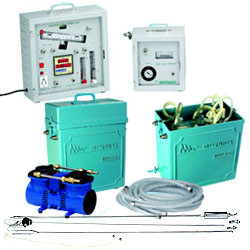Stack Monitoring Kit is designed to serve the most crucial purpose of measuring the total volumetric discharge of particulate matter and gaseous pollutants from the Boiler, DG stacks, Process outlets, Scrubber Outlets.
It is very important to measure harmful pollutants emitted from industries in order to take decisions based on collected data to minimize the pollution. Stack monitoring kit plays major role in collecting samples from chimneys / Stacks in Stack monitoring Procedure.
All the Gaseous stream effluents in accordance with the Air Act 1981 (Prevention &Control of Pollution) by which all industrial establishments have to measure and monitor emissions from their plants and keep them under controlled limits. To ensure this, each & every company (chemical, Pharmaceutical, manufacturing) should monitor their gaseous pollutants discharged into the environment at regular interval.
Stack Monitoring Kit / Equipment consists of:
- Pitot tube: “S-type” fabricated from SS304 or equivalent grade. Coefficient of Pitot tube should be above 0.95 in stack monitoring system.
By taking proper/ representative sample from stack Monitoring kit, we can calculate
- Stack Velocity
- Volumetric flowrate per hour
- PM (Particulate matter)
- Moisture Content
- Gaseous Contents
Stack Monitoring kits are very lightweight and can be easily carried to site. Also it has inbuilt battery which can be charged, so no need of power supply while monitoring stack. We can also adjust flow control as per our requirement.
The Stack Monitoring kit is used to measure total volume, velocity, Flowrate and Moisture content of discharged gaseous pollutants which includes particulate matter, SO2, NO2, etc. The gases which needs to be measured are pre-defined by government agencies such as CPCB and EPA.
Stack monitoring is performed to monitor emissions thrown out of the stack, chimneys DG Sets, Boilers etc. in the air. It is also referred to as air quality monitoring. In this process, the operator climbs the stack to a specific height and then he/she inserts a pitot tube from the stack monitoring kit to the available port from Stack and keep it for a certain period to collect the sample.
Stack monitoring is the process that enables EHS managers, inspectors and directors to measure the level of pollutants are released into the atmosphere from the Stack.
Stack monitoring is performed to monitor emissions thrown out of the stack, chimneys DG Sets, Boilers etc. in the air. It is also referred to as air quality monitoring. The Major pollutants are checked from stack monitoring are Particulate matter (PM2.5, PM10), SO2 and NOX. It is performed on regular basis as per instructions from Pollution control boards.
Stack emissions are pollutants thrown out of the stack. Those pollutants can be Particulate Matter (PM2.5 and PM10), Carbon Dioxide (CO2), Carbon Monoxide (CO), Sulphur Dioxide (SO2), Oxides of Nitrogen (NOx), Methane (CH4) and Hydrocarbon Compounds.

Comments
Post a Comment